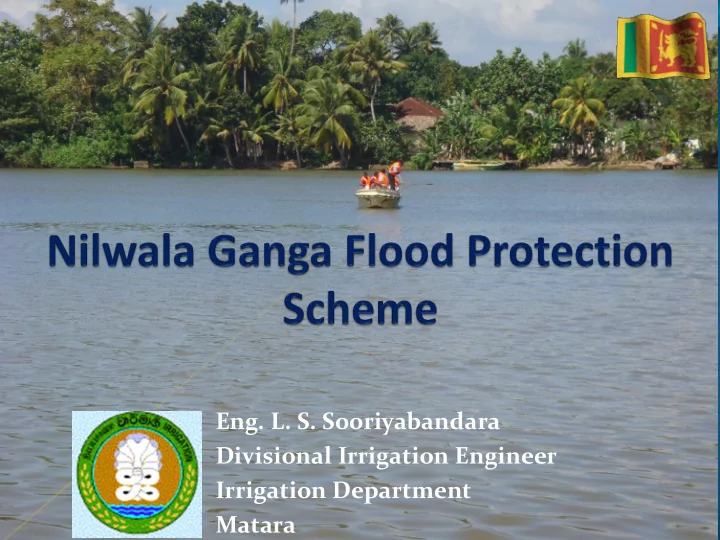

Eng. L. S. Sooriyabandara Divisional Irrigation Engineer Irrigation Department Matara
River Basin Map PITABEDDARA KOTAPOLA AKURESSA MATARA
River Basin Information Catchment Area : 970 km 2 Length of the river : 70 km Average Annual Rainfall : 1650 -4000 mm Average Annual Discharge : 1500 MCM
Average Rainfall 350 300 250 Rainfall in mm 200 Long term Average 150 100 50 0 Oct Nov Dec Jan Feb Mar Apr May June Jul Aug Sept Month
Nilwala Flood Prone Area
1960 Feasibility study Engineering Consultants, Inc . Irrigation Department, Sri (ECI), Denver Colorado, USA Lanka Three Basin Study Objectives Gin Ganga Flood Protection Nilwala Ganga Power Generation Kalu Ganga Irrigation Water Supply Transbasin Diversion
Proposal in Nillwala under Three basin Study Large scale reservoir in upper catchment
Nilwala Ganga Flood Protection Scheme Period of construction : 1980 s Financial & technical Support : French Government Original Proposals Developing low lands at RB for paddy cultivation (Stg. I) Protection of LB paddy cultivation area from flooding (Stg. II) Construction of multipurpose reservoirs in the upper catchment. (Stg. III) Protection of Matara city and suburbs from flooding (Stg. III)
General DIGILI OYA HULANDAWA Map of Project
Strategy Applied Embanking (Flood Bunds) Channelization (Drainage System) Storm water evacuation by pumping
What was implemented by French in 1980s Stage I & II - To develop low lands in the lower basin (Kiralakele & Kadawedduwa) for paddy cultivation (2000 ha in each). Additional works - Minor protection for Kadduwa sector & Akuressa lift irrigation scheme - Bypass canal at Panadugama
Kadawedduwa Sector Kadduwa Sector Kiralakele Sector Sea outfall Unprotected zone Indian Ocean
Flood Bunds
Panadugama Bypass canal Panadugama spill Bypass canal Akuressa town
General View on Stage I & II of the Project Paddy Cultivation in Kiralakele was not successful due to poor soil conditions and shortage of water. (only about 500 ha out of 2000 is cultivated) Stage II (LB side) is successful, but the operation cost of pumps is extremely high. Extent of unprotected area is very high
Lapses of the Nilwala Ganga Flood Protection Scheme Higher flood levels in unprotected area of 3000 ha Formation of acidity in 800 ha of paddy lands in Kiralakele area High Costs of Operation and Maintenance
Crucial Environmental Issues Causes Effects Natural Flooding Unplanned Saline water intrusion developments Water pollution Urbanization Soil erosion Sand mining Siltation De-forestation Water Scarcity Plantations, Industries Soil Salinity Increase of population Acidity
Present Requirements (1) Implementing stage 3 with necessary changes to suit present conditions (i) Digilioya Reservoir , Aparekka Ara & Batuwita reservoir (ii) Enlarging river channel with removing obstacles to flood way. (2) Rehabilitation of stage II (LB area) & Pumps of Akuressa Lift Irrigation sch. (3) Find alternative solution for Kiralakele (RB side)
Stage 3 ( 1 ) Construction of reservoirs in the upper catchment Objectives - Providing Irrigation facilities Developing Hydro power Mitigation of floods (Upper basin & the unprotected area, either side of river)
Stage 3 (continued) (2a) Construction of bypass canal for the river. Objectives - To protect the city of Matara & suburbs from flooding - Lowering the flood levels of unprotected area (2b) Alternative proposal – Enlarge the river channel from Bandaththara to sea out fall
Proposed Reservoir Location
PROPOSED RESERVOIRS Kotapola Tank Urawa Tank Kirama Tank Digili Oya Tank Akuressa Kamburupitiya KadukannaTank Batuwita Ara Tank Aparekka Tank Matara
Proposed River Enlargement BANDATHTHARA THUDAWA PUMP STATION SEA OUTFALL
Nilwala Transbasin Diversion Objectives Diversion of Gin - Nilwala surplus water to Hambantota Power Generation Gin – Nilwala Flood Mitigation
Locations of Proposed Tank Pitadeniya Kotapola Ampanagala
Pitade deniya niya Kotapol apola POWER PLANT CASCADE ROUTE OF GIN – NILWALA NT Ampanagal gala DIVERSION PROJECT Kirama ama Muruth thawe awela Chandr drika ika Wewa wa
Project Lay Out Map cont……
Project Lay Out Map
Kiralakele Sector Most affected area after project
Kiralakale Drainage Bund Thudawa pump house Nilwala River
Solution to eradicate drainage problem of Kiralakale…. Kirala kele is in the right bank of the basin, which is boggy and marshy and the land is in the same level with the sea. In 1988 the area was isolated by flood bunds and a pump house was provided to evacuate drainage water in to the river at Thudawa.
Kiralkale
Scheme Data In Matara District Area of the scheme = 2000Ha Farmer organization of the scheme = 33 Total number of Regulators = 70
Canal Network
Primary canal system Canal Name Canal length km S 7.0 T 8.0 U 8.0 48 km. Length of secondary - 48
Drainage Methods Two methods used Gravity outlet Pumping
Draining Gravity outlet Pump House
Draining … Gravity outlet Pump House
Land Elevation Effect 0.3m Sea Level Paddy Fields Paddy Fields upto 0.3m above 0.3m above Sea from Sea Paddy Fields – below Sea Level Level Level PH 5.0 – 5.5 PH 4.0 – 5.0 PH 2.5 – 3.5 Drainage Canal
Land Degradation Water logging Vegetation
Soil Acidity & Salinity Marshy low land with mangroves Rich with Iron Pyrites (Fe2S) When water table is decreasing… Oxidization taken place Form Acidity Displacement of Iron & Aluminium ion Critical & Limitative condition Toxic soil in paddy cultivation
Also…… In dry season Salts creep to the top soil due to evaporation & capillary action Harmful salinity Distribute this soil problem to adjoining areas due to the variation of water table
Challengers … Maintenance of canal network
Challengers … Water Management structures
Potential Nature Parks
Future of farming Change of Land use
Detention Reservoirs as a Flood Control Measure Detention ponds Multi purpose reservoirs Temporary detention area Permanent pool Rive r Inlet & Outlet canals Sea
“ Water is the planet's essential resource, the primary control on health and crucial to the security of food, energy Thank you and biodiversity. Despite this, water's role is not well understood and this precious resource remains undervalued ”
Recommend
More recommend